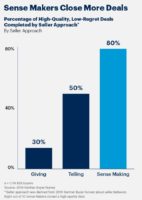As a sales rep in the era of Buyer 2.0, you need to make your customer eat out of your hands in order to succeed in the high value B2B technology business.
For the uninitiated, the phrase “eat out of hands” means
To be completely accepting of whatever one says.
In the aftermath of the pandemic, pundits exhort companies to adopt digital selling. According to the popular narrative, digital selling means putting out content so that the prospect can craft their own solution.
According to me, there’s a lot more to digital selling than that.
In Just Because Customers Can Find Their Own Solutions Doesn’t Mean They Will, we saw many reasons why sales reps are still key to the sales / purchase journey. One of them is the challenge faced by prospects in finding the right solution in their context.
As the old saying goes “there’s more than one way to skin the cat”. Likewise, a given business pain area can be solved in multiple ways. In our single-minded dedication to our product or service, we often assume that the way in which our product / service solves a problem is the only way in which the customer can have that problem solved.
That’s a misguided assumption.
As I highlighted in Warehouse Pilferage: One Problem, Many Solutions, the same business problem has three solutions, only one of which comes under the purview of B2B technology.
To win, our B2B technology sales rep needs to steer the prospect towards our way – and away from our competitors’ ways.
This begs the following question:
Why would the prospect let himself be steered by a sales rep?
That’s a valid question. The notion of eating out of your hands enters the picture in the answer to that question.
Let’s unpack it.
 In New B2B Sales Approach to Win in Today’s Information Age, Gartner asserts that prospects are able to access high quality information by themselves but also warns that the improved quality of information is now accompanied with information overload, contradictory information, and other problems.
In New B2B Sales Approach to Win in Today’s Information Age, Gartner asserts that prospects are able to access high quality information by themselves but also warns that the improved quality of information is now accompanied with information overload, contradictory information, and other problems.
From personal experience and anecdata, I totally agree with Gartner.
Gartner avers that sales is required more than ever before to guide prospects in order to solve these problems, and goes on to propose three styles of sales guidance: Giving, Telling and Sense Making.
Of the three, Gartner finds Sense Making to be the most effective in driving high quality deals.
Sense Making helps customers evaluate information so they are able to prioritize various sources of information, quantify trade-offs and reconcile conflicting information. Sense Making simplifies customers’ learning by helping them evaluate and prioritize relevant information, all while helping customers arrive at their own understanding.
Sense makers help prospects to make sense of the massive amount of information they encounter as part of a purchase and proactively guide them through the buying journey.
Let me illustrate the power of Sense Making with a personal anecdote of how I managed to break into a large account.
This account was a big buyer of computers, networking and software. The company regularly requested quotes from leading IT vendors, including my company.
For some reason, it rejected all my proposals in the past.
Since I knew the value of perseverance in sales, the rejections didn’t stop me from responding to every RFP issued by it.
@no_fear_inc uses a nice diagram to reiterate the evergreen truth that perseverance matters a lot in B2B sales. https://t.co/yOUkmuNVYV pic.twitter.com/96V7jvp8lH
— Ketharaman Swaminathan (@s_ketharaman) October 11, 2017
After submitting yet another proposal, I visited the customer’s office to follow up.
I found the CIO’s assistant flustered.
Purely out of courtesy, I asked him what the problem was.
He said the CIO had entrusted him with the responsibility of evaluating the dozen-odd vendors that responded to their latest RFP (one of whom was my company). He found many contradictions across their bids e.g.
- One vendor claimed that Intel CPU was the fastest whereas the benchmarks supplied by another vendor showed that AMD CPU was faster
- The cheapest quote was from an unbranded PC that claimed to use the same brand of CPU, RAM, hard disk and other components of the branded alternatives; and so on.
Ergo he was at a loss for how to move forward.
I reflexively offered to help – but really expected to shown the door for trying to interfere in a sensitive internal matter.
Much to my surprise, the guy gladly accepted my assistance.
Over the next couple of hours, I helped him navigate through the reams of information and resolve the many apparent contradictions in the competing proposals e.g.
- For their workload, Intel offered better performance; while the AMD benchmarks were not false, they were not relevant in their specific context
- Chip manufacturing was not a perfect science. All CPU manufacturers routinely rejected around 40% of their production. Unbranded PCs used the components from the rejected lot (“seconds” as it was called in the industry) whereas branded PCs used the ones from the accepted lot. So, while the cheapest vendor was not lying, there was a lot more to the truth than its obfuscatory claim.
I cleared up a lot of confusion and added some more perspective to the evaluation.
Soon the guy was “eating out of my hands”.
Long story short, I broke into that account and bagged many deals from that customer over the next few years.
From my personal experience in high value B2B technology sales, I can vouch that the Sense Making style of sales guidance works extremely well.
Making the customer eat out of your hands is key to sense making. The ability to do so on a consistent and repeatable basis comes from the following attributes:
- Familiarity with the customer’s business
- Empathy with their business pain areas and industry hot topics
- Sound knowledge of her product or service
- Ability to connect the dots
- Agility to think on her feet.
You must have noticed the absence of “impartial guidance” from the above list.
According to the popular narrative, sales guidance should be impartial.
That’s simply not true. If prospects want unbiased advice, they will engage with independent analyst firms like Gartner, Forrester, et al.
Every prospect and customer that has sought, received and thanked me for my guidance knew that I worked for a company and that I was paid by that company to project its offerings in the best possible light.
Nobody expects you to root for your competitor. All they expect is that you be sincere in your portrayal of your company’s products and services in their context.
Buyers of enterprise technology also encounter a ton of aspirational selling by sales reps. Accordingly, savvy prospects and customers mentally work out the Finnegans Factor for each rep they interact with.
Finnegans Factor: That number by which you multiply your answer to get the right answer.
By applying the appropriate Finnegans Factor to each rep, customers are able to grapple with the different shades of sincerity of different reps. (Just like if a rep talks too much, they carefully examine everything she has said whereas if a rep talks too little, they carefully examine everything she has not said.) That’s why reps have a differing degree of success in making the customer eat out of their hands.
Before closing, here’s a quick word on Finnegan’s Factor.
I read about the concept in a marketing journal in the library of my alma mater IIT Bombay in circa 1983 and have subsequently found it very useful in explaining many things in Consumer Behavior.
Print and TV operate to totally different timescales. The level of fact checking that's afforded by 24 hour print cycle is unimaginable in hourly TV cycles. Ergo TV has a higher Finnegan's Factor than Print media. https://t.co/dffZbIQAgA
— Ketharaman Swaminathan (@s_ketharaman) July 20, 2020
Notwithstanding its aforementioned provenance, many people have told me that, when they google this term, the only results that show up are mine – the subtext being I coined this expression.
How I wish that were true!
However, since we live in a world where “Google is Truth”, I’m not in any rush to correct their misconception!
https://twitter.com/s_ketharaman/status/1518582554017734662


